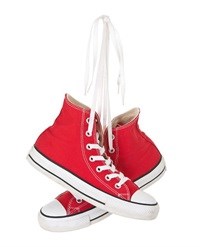
Most readers will know that product features such as shape, pattern, configuration and ornamentation can be registered as trade marks, in much the same way as more conventional identifying features such as brand names and logos can be registered.
Converse's decision to launch these legal proceedings is interesting. In the first place, trade mark registrations for product features such as shape and pattern are still relatively rare, and cases involving such registrations are never easy.
One issue that often comes up is this: are the features that have been registered functional? If so, they won't enjoy protection. Another issue that comes up is this: do the features that have been registered in fact act as indicators of source - in other words, trade marks?
To put it differently, do consumers make assumptions about the source of the product when they see those features? Or, to put it into context, will consumers seeing shoes that have some of the features of Converse shoes - such as a rubber toe front and black stripes - assume that those shoes are Converse shoes or in some way linked with Converse?
In South Africa we had a case involving trade mark registrations that covered features of pattern or ornamentation applied to shoes not that long ago. In this case - which went all the way to the Supreme Court of Appeal - Adidas successfully sued Pepkor for using a four-stripe motif on footwear, something that the court felt was confusingly similar to Adidas's famous three-stripe motif. Interestingly, the court rejected Pepkor's suggestion that it had applied the four-stripe motif simply as adornment or embellishment, rather than as a source indicator. The court had no difficulty with the notion that consumers understand that shoe manufacturers use stripes on shoes as trade marks.
What's equally interesting, I think, is the fact that Converse decided to go after so many retailers, a list that includes some very big names, such as Walmart and Kmart. That's interesting why? Because companies such as Walmart must surely either be significant customers or potential customers of a company such as Converse. This highlights a real dilemma that trade mark owners that are manufacturers have: they are often very dependent on the goodwill of major retailers. So suing them doesn't always make great sense.
This problem comes up a lot in the context of supermarket own-label brands. Readers will be aware that supermarkets often sell their own-label brands in competition with the established brands that they sell. In many cases the own-label brands look remarkably similar to the established brands, and the products are often sold side-by-side.
In a recent article we discussed how, although this does occur in South Africa, this is a particularly contentious issue in the UK. Some people question whether there is any consumer confusion, pointing out that the own-label brands invariably feature different brand names and that, in any event, consumers are so accustomed to the concept of own-label brands that they know what to look out for. This may be so, but there's no doubt that supermarkets do copy the get-ups of established brands for a reason. Perhaps to create the impression that their product is of the same quality as that of the established brand!
There are legal steps that the owner of the established brand can take. A product get-up - which might incorporate features such as colour, shape and typestyle - can be registered as a trade mark. This means that, even if the brand name is not copied, there still might be a case of trade mark infringement. There may be a case of passing off. There may be a case of copyright infringement. There may even be recourse under the Code of the Advertising Standards Authority (ASA).
But it's a rare manufacturer who's prepared to take on a retailer who buys large quantities of its product. Especially a retailer who happens to also use the manufacturer to make its own-label product - it's a weird thing, but many of the own-label products that you see in supermarkets are, in fact, manufactured for the supermarkets by the owners of the established brands.
So what does the trade mark owner do? Does it simply accept that certain retailers will sail very close to the wind or, to put it more bluntly, infringe their trade mark rights? Does it negotiate with retailers, put it to them that intellectual property is important for everybody, and that if they persist with infringing the rights of manufacturers, this will, in due course, lead to a situation where no-one's rights are respected, including those of the retailers?
Does it mediate, something which, naturally, needs the cooperation of both parties? Or does it do what Converse has done, take a number of important retailers to court? What this does do, of course, is send out a very strong message.
But it's risky too, not only because it might alienate customers, but also because there's no guarantee that the company will win in court.
What is certain is that the fact that Converse has taken this pretty drastic step shows just how seriously it takes its intellectual property.
Source: The Times

For more than two decades, I-Net Bridge has been one of South Africa’s preferred electronic providers of innovative solutions, data of the highest calibre, reliable platforms and excellent supporting systems. Our products include workstations, web applications and data feeds packaged with in-depth news and powerful analytical tools empowering clients to make meaningful decisions.
We pride ourselves on our wide variety of in-house skills, encompassing multiple platforms and applications. These skills enable us to not only function as a first class facility, but also design, implement and support all our client needs at a level that confirms I-Net Bridge a leader in its field.
Go to: http://www.inet.co.za